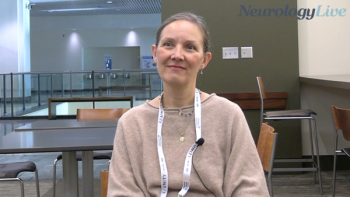
Variable Presentation of SMA in Children and Adolescents
Families with patients with SMA explain the signs and symptoms shown by their children that prompted a doctor’s visit.
Episodes in this series

Crystal Proud, MD: Hello, and thank you for joining this NeurologyLive® Cure Connections® program titled “The Identification and Evaluation of Suspected Spinal Muscular Atrophy in Children and Adolescents During a Telehealth Appointment.” SMA [spinal muscular atrophy] is a genetic condition that involves weakness and progressive atrophy of muscles. It’s caused by loss of motor nerve cells that control movements of muscles. The disease can present at any age with great variability in symptoms and progression of the disease. I’m your host, Dr Crystal Proud. I’m a pediatric neuromuscular specialist at the Children’s Hospital of The King’s Daughters [CHKD] in Norfolk, Virginia. I’m joined today by Dr Zaidman.
Craig Zaidman, MD: Hi, everybody. I’m Craig Zaidman. I’m a child neurologist, and I specialize in nerve and muscle disorders at Washington University in St. Louis, Missouri.
Crystal Proud, MD: Dr Zaidman, you have a patient of yours with us today.
Craig Zaidman, MD: Yes. Briggs was kind enough to join us. Briggs, do you want to introduce yourself and your parents?
Briggs: Hello. These are my parents. This is my dad, Jeremiah, and my mom, Lindsay.
Crystal Proud, MD: It’s nice to meet you both.
Jeremiah: You too.
Lindsay: You too.
Crystal Proud, MD: And I have a patient of mine here today, Miss Hannah and her parents. Hannah, would you like to say hi?
Hannah: Hi. This is my dad, Matthew, and my mom, Charlene.
Crystal Proud, MD: It’s wonderful to have you all here. Thank you so much for joining us. Let’s get started in our discussion. Why don’t we start with Hannah and her family? I’d like for you guys to share with me a bit of your experience leading up to Hannah’s diagnosis of SMA. What did you notice that made you say, “I think we should ask the doctor about this?” Do you remember?
Charlene: I do. When Hannah was about 12 months old, she had recurring ear infections and wasn’t walking yet, and I asked her pediatrician, “What’s going on? Shouldn’t she be walking?” She was pulling up, but she wasn’t walking. She was born in 2004, and they finally put tubes in her ears in January of 2005. After they put tubes in her ears, the pediatrician was like, “Give her about 2 or 3 weeks and she should be cruising.” Afterward, I went back to the doctor in February and they were like, “Let me send her over to get some tests done at CHKD.” They did some blood work. But while we were there, she said, “Her legs feel like jelly.” I was like, “What does that mean?” And she’s like, “I’ll send you over and get the test done and we’ll go from there.”
Crystal Proud, MD: It sounds like you noticed that there were some differences in her achieving some of those early motor milestones, like walking, and difficulty with catching up after an intervention that was felt to potentially help her improve. Briggs, maybe your family can share with us your journey. What signs and symptoms did you notice that prompted you to get into the doctor?
Lindsay: Our story is a little different in the fact that Briggs met all of his milestones. He crawled, he walked, and he rode his bike without training wheels when he was 3. But I knew something wasn’t right when he was 1. I took him to the foot doctor because I thought he had an ingrown toenail, and the foot doctor was adamant that he had the worst case of flatfoot he had ever seen in a child. And we were religious about well visits. He went every time we were scheduled. There were no red flags from the medical side. I thought, “Maybe it is just flatfoot.” He referred us to an orthopedic doctor in Columbia, Missouri. We went there, and he said, “He’s fine. He has flatfoot. He will grow out of it. He doesn’t need surgery or anything like that. He’ll just outgrow it.”
We were relieved leaving Columbia; Briggs was 3 at the time. He was 4, almost 5, when I took him back to the original foot doctor who said he had the worst case of flatfoot, and he said, “No, something still isn’t right. I want you guys to go to Shriners.” So we went to Shriners Children’s St. Louis. You walk into a place like Shriners and your child couldn’t walk, and we were just relieved that they were like, “Nothing is wrong. His hips are fine. His feet are fine. Here are some orthotics and come back in a year.” We were scheduled to go back right when COVID-19 hit, so we didn’t go back. He fell at school a year ago today. The teacher called me and said that he couldn’t get back up and the security guards had to help him up, which prompted a chiropractor visit. From there, that’s how we’re here.
Crystal Proud, MD: What I’m hearing from both stories is a prominence of attention to the legs, the lower extremities, and the feet.
Transcript edited for clarity.
Newsletter
Keep your finger on the pulse of neurology—subscribe to NeurologyLive for expert interviews, new data, and breakthrough treatment updates.



































